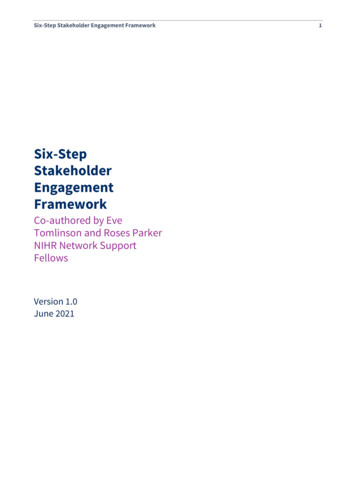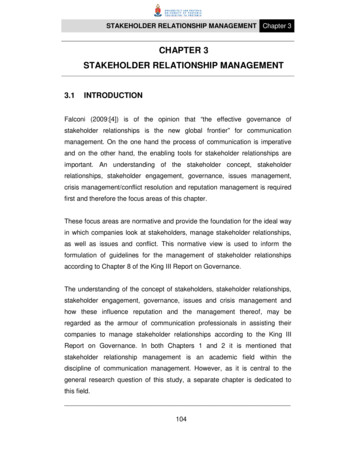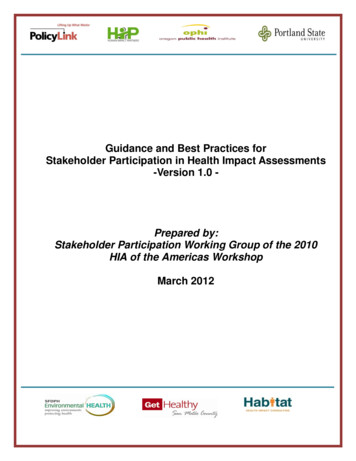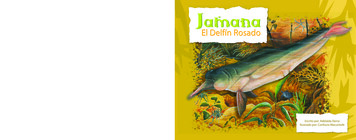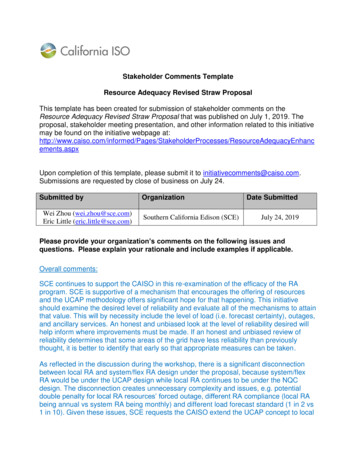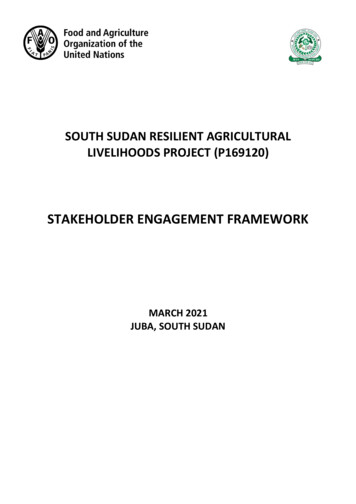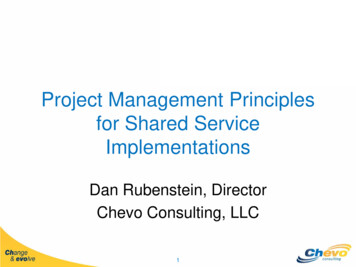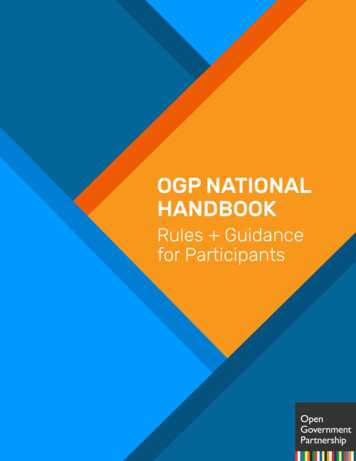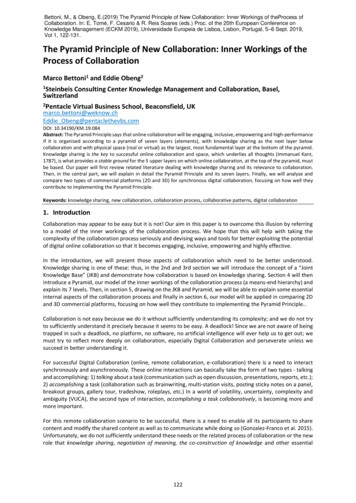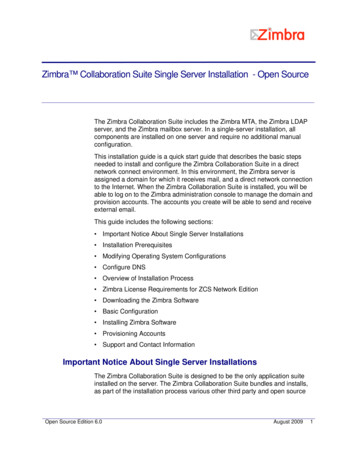
Transcription
StakeholderCollaborationBuilding Bridges for Conservation
StakeholderCollaborationBuilding Bridges for ConservationEcoregional Conservation Strategies UnitResearch and DevelopmentSeptember 2000World Wildlife FundWashington, D.C.
ACKNOWLEDGEMENTSWWF gratefully acknowledges the funding support of the Ford Foundation fordevelopment and publication of this resource.Thanks for their contributions and comments are due to Patty Larson,Barbara Wyckoff-Baird, Alissa Stern, Michael Brown and his colleagues at IRM,Anthony Anderson, Poonam Smith-Sreen, and Bronwen Golder.For copies of this report, please contactEcoregional Conservation Strategies UnitResearch and DevelopmentWorld Wildlife Fund1250 24th Street NWWashington DC 20037Information about WWF can be found at www.worldwildlife.org.Reproduction of this document is permitted, with indication of the source.Design by Nancy Gehman DesignCover illustration by Stuart ArmstrongPrinted on 100% recycled stockPrinted using soy inks
TABLEOFCONTENTSExecutive Summary . . . . . . . . . . . . . . . . . . . . . . . . . . . . . . . . . . . . . . . . . . . . . . . . . . . . . . iii1Overview. . . . . . . . . . . . . . . . . . . . . . . . . . . . . . . . . . . . . . . . . . . . . . . . . . . . . . . . . . 1.1The purpose of this resource book. . . . . . . . . . . . . . . . . . . . . . . . . . . . . . . . . . . . . . . 1.32Defining Stakeholder. . . . . . . . . . . . . . . . . . . . . . . . . . . . . . . . . . . . . . . . . . . . . . . . 2.1Are there different types of stakeholders? . . . . . . . . . . . . . . . . . . . . . . . . . . . . . . . . . 2.2CASE 1: From a Coalition of Allies to Broad Participation . . . . . . . . . . . . . . . . . . . . 2.43Collaboration Goals. . . . . . . . . . . . . . . . . . . . . . . . . . . . . . . . . . . . . . . . . . . . . . . . .What are the characteristics of a collaboration process? . . . . . . . . . . . . . . . . . . . . . .Are there degrees of collaboration? . . . . . . . . . . . . . . . . . . . . . . . . . . . . . . . . . . . . . .Where are you on the collaboration continuum? . . . . . . . . . . . . . . . . . . . . . . . . . . . .What are the components of a collaboration process? . . . . . . . . . . . . . . . . . . . . . . . .What are the challenges for conservation organizations?. . . . . . . . . . . . . . . . . . . . . .4Stakeholder Identification. . . . . . . . . . . . . . . . . . . . . . . . . . . . . . . . . . . . . . . . . . . . 4.1CASE 2: Finding the Balance among Different Stakeholders . . . . . . . . . . . . . . . . . . . 4.4CASE 3: Women as Important Stakeholders. . . . . . . . . . . . . . . . . . . . . . . . . . . . . . . . 4.6Who should be involved, and when? . . . . . . . . . . . . . . . . . . . . . . . . . . . . . . . . . . . . . 4.7Is stakeholder representation important? . . . . . . . . . . . . . . . . . . . . . . . . . . . . . . . . . . 4.7CASE 4: Exploring Local Representation Options . . . . . . . . . . . . . . . . . . . . . . . . . . . 4.8CASE 5: Coalitions for Conservation . . . . . . . . . . . . . . . . . . . . . . . . . . . . . . . . . . . . 4.10Is there a role for coalitions, associations, and sector groups? . . . . . . . . . . . . . . . . . 4.11How do differences in power affect stakeholder participation? . . . . . . . . . . . . . . . . 4.115The Collaboration Process . . . . . . . . . . . . . . . . . . . . . . . . . . . . . . . . . . . . . . . . . . . 5.1When do stakeholders commit to collaboration? . . . . . . . . . . . . . . . . . . . . . . . . . . . . 5.3How do stakeholders define reasons for collaboration? . . . . . . . . . . . . . . . . . . . . . . . 5.3CASE 6: Bringing Stakeholders Together . . . . . . . . . . . . . . . . . . . . . . . . . . . . . . . . . . 5.4What capacities do stakeholders need? . . . . . . . . . . . . . . . . . . . . . . . . . . . . . . . . . . . 5.5How important is the design phase?. . . . . . . . . . . . . . . . . . . . . . . . . . . . . . . . . . . . . . 5.6What are the ground rules? . . . . . . . . . . . . . . . . . . . . . . . . . . . . . . . . . . . . . . . . . . . . 5.7What roles might emerge during the process? . . . . . . . . . . . . . . . . . . . . . . . . . . . . . . 5.8CASE 7: Two Stakeholder Participation Structures . . . . . . . . . . . . . . . . . . . . . . . . . . 5.10Which organizational structures encourage involvement? . . . . . . . . . . . . . . . . . . . . 5.12How can communication help? . . . . . . . . . . . . . . . . . . . . . . . . . . . . . . . . . . . . . . . . 5.12Are shared goals important? . . . . . . . . . . . . . . . . . . . . . . . . . . . . . . . . . . . . . . . . . . 5.13What are the stages in developing common goals? . . . . . . . . . . . . . . . . . . . . . . . . . 5.13How do you distinguish positions from interests? . . . . . . . . . . . . . . . . . . . . . . . . . . 5.14How can you assess options? . . . . . . . . . . . . . . . . . . . . . . . . . . . . . . . . . . . . . . . . . . 5.153.13.23.33.43.53.5Table of Contentsi
6Supporting Implementation . . . . . . . . . . . . . . . . . . . . . . . . . . . . . . . . . . . . . . . . . .Why is external support important? . . . . . . . . . . . . . . . . . . . . . . . . . . . . . . . . . . . . . .What implementation structures are needed?. . . . . . . . . . . . . . . . . . . . . . . . . . . . . . .How important is monitoring? . . . . . . . . . . . . . . . . . . . . . . . . . . . . . . . . . . . . . . . . . .CASE 8: Implementation Structures . . . . . . . . . . . . . . . . . . . . . . . . . . . . . . . . . . . . . .What indicates progress? . . . . . . . . . . . . . . . . . . . . . . . . . . . . . . . . . . . . . . . . . . . . . .7Conflict Resolution . . . . . . . . . . . . . . . . . . . . . . . . . . . . . . . . . . . . . . . . . . . . . . . . . 7.1How can facilitators address conflicts? . . . . . . . . . . . . . . . . . . . . . . . . . . . . . . . . . . . 7.2What are the most effective methods? . . . . . . . . . . . . . . . . . . . . . . . . . . . . . . . . . . . . 7.36.16.26.36.36.46.5Bibliography . . . . . . . . . . . . . . . . . . . . . . . . . . . . . . . . . . . . . . . . . . . . . . . . . . . . . . . . . . . . 8.1iiBuilding Bridges for Conservation
EXECUTIVESUMMARYBy explaining the principles of collaboration, introducing a range of tools, and reporting ona number of case studies from around the world, this resource book aims to help practitionersand stakeholders develop a wider appreciation of how to approach and structure a collaboration process. Stakeholders are encouraged to use the ideas and information provided here todevelop new and innovative relationships with those individuals and institutions who canhelp make collaboration a reality.Stakeholder collaboration is a process that will go through many iterations. Full collaborationor partnership is not always going to be the outcome. Instead, the process that stakeholdersgo through may reveal that other forms of action—campaigns, education, policy development, or advocacy—are more appropriate given the conservation goals and objectivesidentified, and the roles, positions, and interests of the various parties involved. Rememberthat facilitators, convenors, education and communication specialists, capacity building andconflict resolution experts, policy advisors, or lobbyists all can offer important advice andsupport to the collaboration process.Whatever the outcome, the stakeholder collaboration process can help a range of stakeholders—allies and opponents, public and private sector, communities and individuals—to develop a better understanding of the issues and challenges involved in achievingconservation goals and objectives at a variety of scales.We encourage you to use this publication as a “working document.” Test it and report backto us on the utility of the processes and tools that this resource introduces. Where new ideas,approaches, and opportunities emerge, we hope you will supplement what is presentedhere and share your learning with us.At the end of the day, conservation is about managing human activity and its impact on theenvironment. Stakeholder collaboration is one of the processes that can help you achievethat goal. We hope that you find this introduction to stakeholder issues and options helpful toyour daily work. For further information, please do not hesitate to contact us.ECOREGIONAL CONSERVATION STRATEGIES UNIT, WWF-USExecutive Summaryiii
C H A P T E R1OverviewThe purpose of this resource book . . . . . . . . . . . . . . . . . . . . . . . . . . . . . . . . . . . . 1.3Overview1.1
1C H A P T E ROverviewThis publication provides an introduction to concepts relevant to stakeholder collaboration. It introduces a range of tools that conservation practitioners and partners can useto develop effective working relationships.Key points made in this publication include1.2 Stakeholder collaboration can help to address conservation issues at any scale. All key stakeholders need to be involved in the collaboration process if conservation is tobe achieved at ecoregional scales. It is important for stakeholders to have the opportunity to come together to develop andshare their visions and agendas. Deciding who is “inside” or “outside” a collaboration process will always be relevant toconservation outcomes and their sustainability. The history and dynamic of stakeholder positions and interests must be understood beforeany form of collaboration is initiated. All stakeholders will come to the process with their own biases. Reaching consensus on the ground rules is fundamental to success. Monitoring and evaluation of the quality of collaboration is as important as measuringspecific conservation outcomes.Building Bridges for Conservation
The concepts introduced in this resource book will be relevant to planners and managers asthey tackle conservation challenges. Given the pace at which collaborative ventures amongconservationists, local communities, governments, and the private sector are evolving, it isassumed that the processes and tools presented here will be supplemented over time with newideas and techniques. It is appropriate therefore to see this publication as a work in progress.The purpose of this resource bookEffective conservation of biological diversity is dependent on a wide and diverse range ofstakeholders acting collaboratively. Today, large-scale forces such as consumption, technology,investment and trade policies, corruption, and limited capacity drive the threats facing priorityconservation areas worldwide. Working independently, organizations cannot by themselvesrespond adequately to these pressures. Therefore, cooperation between interested and affectedpeople and groups is necessary if the problems are to be addressed coherently.This resource book has been designed to assist people engaged in conservation at all levels todevelop their understanding of, and capacity for, collaboration. The book poses a number ofkey questions about how you achieve stakeholder collaboration and discusses a range of concepts and actions that can assist practitioners in identifying potential stakeholder collaborationopportunities and needs, and determining what is best for each situation.Central to the questions, discussions, processes, and tools presented in this resource book arelessons and conclusions that have emerged from past conservation experiences. Specifically: The increasing scope and ambition of conservation initiatives, such as ecoregionalconservation, will require a commitment to dialogue and collaboration with a diverserange of stakeholders. The goals of any collaboration venture must be clarified before engaging stakeholders.Goals help identify and target those interests that need to be represented in collaborationprocesses and those that can be left out. Issues, rather than geographic limits (place), will increasingly drive stakeholder actionsas conservation programs are conceived and implemented across larger scales. Dialogue that is open and transparent is critical to long-term success. Stakeholder collaboration is a process that requires the opportunity and space forparticipants to listen to and learn from each other.Overview1.3
NOTES.1.4Building Bridges for Conservation
C H A P T E R2DefiningStakeholderAre there different types of stakeholders? . . . . . . . . . . . . . . . . . . . . . . . . . . . . . . . . 2.2CASE 1: From a Coalition of Allies to Broad Participation . . . . . . . . . . . . . . . . . . . . 2.4
2C H A P T E RDefiningStakeholderAstakeholder is any person, group, or institution that— positively or negatively—affects or is affected by a particular issue or outcome. This book uses“stakeholders” to refer to people, institutions, or social groups that are involvedin, or affected by, decision making regarding biodiversity conservation issues. While thisdefinition is seemingly straightforward, it is often difficult to answer fundamental questionssuch as these: Who are “the people”? What does “institution” mean? What are the limitsto a “social group”? Yet, these questions must be answered if the right stakeholders are tobe identified and mobilized.This resource book is designed to help practitioners develop a more precise understanding ofthese and other stakeholder-related questions so that field-level interactions and collaborationefforts can be improved upon. Being aware of the imprecision or limitations of terms andconcepts is a key first step in clarifying what is needed to enable stakeholder collaborationthat results in conservation successes.Are there different types of stakeholders?Different interest groups will have differing stakes in the management of resources, basedon their use of and historical relationship with resources.Primary stakeholders include those who, because of power, authority, responsibilities,or claims over the resources, are central to any conservation initiative. As the outcomeof any action will affect them directly, their participation is critical. Primary stakeholderscan include local community-level groups, private sector interests, and local and nationalgovernment agencies.2.2Building Bridges for Conservation
This category of stakeholder also includes, by virtue of the power they wield, those who havethe capacity to influence collaboration outcomes, but who may not themselves be directlyaffected by them. This group can include politicians and officials at the local, national, andregional levels, and international agencies (such as multilateral donors) who control policies,laws, or funding resources. Failure to involve primary stakeholders in collaboration effortsfrom the start can lead to subsequent implementation, technical, or political difficulties inachieving conservation objectives.Secondary stakeholders are those with an indirect interest in the outcome. Dependingon the issue, secondary stakeholders may, for example, be the consumer (who is interested inthe continuing availability of a product), the company employee (who is concerned about jobsecurity), or the tourism operator (who wants to know whether an ecotourism destinationwill to continue to be accessible to clients). These stakeholders may need to be involvedin collaboration processes, but their role is peripheral to that of primary stakeholders, so theymay need to be involved only periodically.Secondary stakeholders may need to have a role, for example, in identifying the costs andbenefits of their interests or products, yet they may not need to be involved in all aspects ofconservation initiatives. Facilitators or convenors of collaboration processes need to planwhen and how to include both primary and secondary stakeholders, as well as to monitorchanges in their interests and influence.Opposition stakeholders may have the capacity to adversely influence outcomes throughthe resources and influence they command. While they may negatively influence differentaspects of conservation planning, particularly at early stages, it is crucial to engage them inopen dialogue. While conservation groups increasingly recognize the importance of involvingtheir adversaries, they have limited experience in doing so. This will no doubt have to changeover time if conservation is to be achieved.Marginalized stakeholders —such as women, indigenous peoples, and other impoverished and disenfranchised groups—may in fact be primary, secondary, or oppositionstakeholders, but may lack the recognition or capacity to participate in collaboration efforts onan equal basis. Particular effort must always be made to ensure their participation. Strategicforesight is needed to determine the time and support required to enable them to organizethemselves and to participate in a collaboration process.In some cases stakeholders are easy to identify. In other cases, a more in-depth understandingof the issues involved in a particular situation is needed to determine who should be includedin the early phases of the process. For a variety of reasons stakeholders may disagree aboutwho should be included in dialogue. It may be that a group is perceived as too combative,or is not thought to have the appropriate skills to participate effectively. These objections mayor may not be justifiable and may often be the result of historic biases held by stakeholdergroups. While assumptions are inevitable, it is important that the initial stakeholderDefining Stakeholder2.3
CASE 1From a Coalition of Allies to Broad ParticipationThe Gulf of California ecoregion covers an area of 280,000 square kilometers (108,108square miles) and provides critical habitat for over 5,000 species and fauna (including 30species of marine mammals).In 1999, World Wildlife Fund (WWF) formed a coalition (the “Core Coalition”) with ConservationInternational (CI) and the Mexico Fund. This formal coalition among WWF and two establishedorganizations actively operating in the gulf developed a conservation vision for the Gulf of Californiaecoregion that it is now advocating and sharing with other local conservation organizations. As otherorganizations are recruited to share in the core coalition’s vision, a wider coalition encompassingthose who contribute to the conservation of the gulf will be established.To date, the coalition established in the gulf has been open to conservation allies only. However, asthe elaboration of a biodiversity vision and conservation plan for the ecoregion is gaining momentum, there is a growing recognition that a wider range of stakeholders needs to be involved in theplanning dialogue. The power and influence of key stakeholders like the shrimp fishing industry,whose actions will be fundamental to achieving the vision for the ecoregion, necessitates that they beengaged in dialogue with the conservation coalition as soon as possible. Similarly, local communitieswho depend on gulf resources for their livelihoods need to know that the vision of the conservationcoalition is not a threat to them.In anticipation of the need to extend the vision and conservation dialogue to other stakeholders inthe ecoregion, WWF has commissioned a stakeholder survey. The survey will be designed to explorethe interests, needs, and desires of a wide range of audiences in the ecoregion so that appropriatecollaboration, communication, and education strategies can be developed.Initially conceived as a tool to shape communications in the gulf, WWF now sees the survey as away in which it can begin to incorporate a wider range of stakeholder views and objectives into aconservation plan for the ecoregion. In addition, through open and transparent sharing of the surveyprocess and results, the coalition partners hope that stakeholders will be encouraged to becomeactively engaged in conservation planning and programming for the gulf.The lessons from the evolution of stakeholder engagement in the Gulf of California are When strong, established conservation organizations with like-minded visions are present inan ecoregion, it may be appropriate to explore coalition options with them. As a vision is developed for an ecoregion, and pressures and threats are identified, the primarystakeholders associated with those pressures need to be actively engaged in dialogue and action. Information, communication, and education tools and processes should be used from theoutset to facilitate interaction with those stakeholders who are not involved in, or natural alliesof, a coalition. Information gathered through surveys should be shared with all stakeholders (not just allies), togenerate a wider understanding of the conservation issues and opportunities in the region.SOURCE: BRONWEN GOLDER. GULF OF CALIFORNIA TRIP REPORT 2/00. INTERNAL REPORT FOR WWF-US,WASHINGTON, D.C.2.4Building Bridges for Conservation
identification process avoids reaching premature conclusions about which stakeholders shouldor should not be involved.Initially, dialogue should be as open and participatory as possible, encouraging stakeholdersfrom a variety of backgrounds and perspectives to contribute to the identification and framingof collaboration goals and objectives. If the process is not participatory there is a risk that itwill quickly become dominated by the strongest, loudest, or best resourced groups who seekto shape the process for their own objectives. Over time it may be determined that additionalinterests must be brought into the dialogue and the process needs to be open enough tofacilitate this.Given the challenges that “open participation” in a collaboration process brings (in termsof multiple, often conflicting perspectives and interests), many groups choose to promotecollaboration more gradually. In these cases, “start-up” involves bringing together like-mindedgroups and allies. Steering committees can be established by these groups to formulate sharedgoals and objectives, and assess and strengthen capacities before a wider collaborationprocess is initiated.In some instances initial dialogue may lead to consortiums, alliances, or coalitions. Whilethis approach can provide for a strong and coherent voice, there are associated risks. Theseinclude the premature establishment of partnerships before issues, opportunities, andappropriate stakeholder roles and responsibilities have been fully defined. When allianceswith like-minded groups only are formed, the risk of generating negative reactions amongother stakeholders can increase due to perceived “exclusivity.” Effective information sharing,communication, and public education can help alleviate these risks. Development of astrategic plan for progressively bringing in other key stakeholders—primary, secondary, oropposition—will also be essential.The number of parties engaged in the collaboration process is also an important consideration. All stakeholders do not need to participate all the time, or to the same degree. Reviewof who is participating in a conservation initiative should be made on a regular basis,and participation revised as needed.Defining Stakeholder2.5
NOTES.2.6Building Bridges for Conservation
C H A P T E R3CollaborationGoalsWhat are the characteristics of a collaboration process? . . . . . . . . . . . . . . . . . . . . . 3.2Are there degrees of collaboration? . . . . . . . . . . . . . . . . . . . . . . . . . . . . . . . . . . . . . 3.3Where are you on the collaboration continuum? . . . . . . . . . . . . . . . . . . . . . . . . . . . . 3.4What are the components of a collaboration process? . . . . . . . . . . . . . . . . . . . . . . . . 3.5What are the challenges for conservation organizations? . . . . . . . . . . . . . . . . . . . . 3.5
3C H A P T E RCollaborationGoalsStakeholder collaboration is a process through which groups with similar or differentperspectives can exchange viewpoints and search for solutions that go beyond theirown vision of what is possible.Collaboration goes beyond people participating (passively or actively) in a process. It alsoextends beyond communication, cooperation, and coordination, even though these are keyelements in the process. Collaboration in this resource book refers to a mutually beneficialrelationship between two or more parties who work toward common goals by sharingresponsibility, authority, and accountability for achieving results.What are the characteristics of a collaboration process?Collaboration relies on trust, inclusion, and constructive engagement to achieve a broadcommon purpose. It does not use advocacy, exclusion, and power over others to achieve itsends. Power and status differences among participants are de-emphasized and ownershipof the process is shared (see checklist, p. 3.3). Stakeholder collaboration can, in the rightcircumstances, provide a powerful approach to responding to complex problems thatisolated efforts cannot solve.Increasingly, conservation organizations are pursuing collaboration that focuses on buildingand maintaining a long-term relationship with key stakeholders. This does not mean therewon’t be conflict, but when conflicts arise they can be addressed within a collaboration framework. It is therefore extremely important that organizations that take on the role of promoteror facilitator of collaboration processes understand how conflicts emerge or are exacerbated.3.2Building Bridges for Conservation
CCollaborative processes are most likely tosucceed when there is room for negotiation;when stakeholders need each other to achieveboth individual and shared goals; and when thereis a willingness to participate. Collaboration alsotends to be effective when the likely results ofnot collaborating are increased conflict, resourcedegradation, threats of litigation, or worsenedrelations among interdependent parties.Collaboration is not, however, always the mostappropriate or effective way in which to achieveconservation results (see checklist, p. 3.5).HECKLISKey Characteristics of Collaboration1Inclusive and non-hierarchical participation.2Participant responsibility for ensuring success.3A common sense of purpose and definition of the problem.4Participants educating each other.5The identification and testing of multiple options.6Participants sharing in the implementation of solutions.7People being kept informed as situations evolve.ADAPTED FROM: CARPENTER, 1990.In any collaboration exercise some powerfulstakeholders may refuse to participate, someuninvited stakeholders may want to participate,and others who begin the process may choose to opt out. While each of these circumstancescan make it difficult to work collaboratively, most situations do involve a mix of favorableand unfavorable conditions. It is more often a question of what degree of collaborationis possible or appropriate, rat
This resource book is designed to help practitioners develop a more precise understanding of these and other stakeholder-related questions so that field-level interactions and collaboration efforts can be improved upon. Being aware of the imprecision or limitations of terms and
